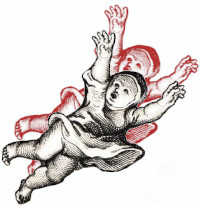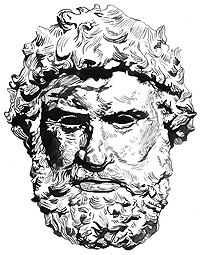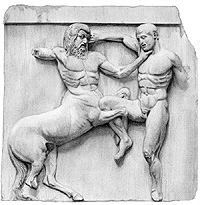Note
I have retagged this book review to show up under the Hemavore tag as well as the book review tag so that readers of that vampire serial I have been writing with Dominick Mattero can get a glimpse into the book I used as my secondary source. My primary source was Reay Tannahill's Flesh and Blood, which is also reviewed on the blog page of this site.
1914, reprinted in 2011 by Wermod & Wermod, Arbergele and Indianapolis, The Palingenesis Project, with an introduction by Kevin McDonald, and expanded and reorganized notes by Alex Kurtagic, with a newly commissioned dust cover painting by Alex Kurtagic, 408 pages, with one line map of French Saint-Domingue
As a testament to courage in publishing this release by Wermod & Wermad is commendable. As I completed my reading of this seminal work I was viewing a PBS documentary of the black American experience with a black friend. We were both disturbed by the fact that not a single scholar or commentator who was not of African American descent was permitted an opinion. Whites, in our intellectually segregated society, are not permitted an opinion on the plight of African Americans. This points to the still strong opinion among American liberals that whites have a genetic antipathy toward other races that cannot be overcome via even the most rigorous objective scholarship. Therefore Lothrop Stoddard’s history of a black slave rebellion in the colony which is now the nation of Haiti, can have no possible value.
There is a flip side to this ignorant modern belief in genetic determinism, as exemplified by Kevin MacDonald’s introduction, in which he holds up Stoddard’s history as a study of a microcosmic race war that will be reflected in an attack on whites by the racial descendents of all of those their ancestors abused. See my review of the introduction on this page under the title ‘The Ideology Of Western Suicide’.
So, as a reader who is vigorously seeking out scholarship by men of the pre-mind-fuck age before America’s ‘Greatest Generation’ inaugurated modern homogenized multi-cultural self-worship and the disparaging of any knowledge held before the great cleansing of WWII as ‘false’, I found myself approaching Lothrop Stoddard’s 1914 Harvard Ph.D. thesis between two pillars of raging prejudice, hungry for what I would find between these veils of ignorance and hate.
The French Revolution in San Domingo, after two readings, appears to me as a sterling example of minimally biased liberal scholarship. The only bias’ I found Stoddard guilty of were:
1. The view that white people being killed by blacks was a fact of more gravity than blacks being killed by whites, or blacks being killed by blacks, or browns being killed by browns, or any of the other myriad combinations of cross-ethnic killing that was the subject of his book. I ask you though, be you brown, black, white, yellow or red [despite our current brown President’s assertion that there was never a red-skinned race living on this continent], doesn’t it give you an even more horrific chill when you consider people who look like you being killed? Does not a woman watching a movie about a man slaughtering women experience more horror than the man seated next to her? Perhaps we can forgive the man this all too organic fear of alienated death.
2. As all of the thousands of historians I have read have asserted before and after his time, Stoddard places a positive value, or a ‘goodness’, upon pure economic production. Therefore, despite the many horrors of its operation that he enumerates, the vast prison farm of French San Domingo is, in his scholar’s mind’s eye, the ‘Jewel of the West Indies’, a paradise of profitability to be marked—like the Great Wall of China, which literally used men as mortar—as an achievement of Mankind.
Other than those two repeated prejudices, the first commonly held by most people, the second commonly held by most historians, I find Stoddard guilty of no racism, prejudice, hate, or ignorance. I find him to be a scholar on the order of Barbara Tuchman and Will Durant, only lacking the former’s narrative flare and the latter’s philosophical insight. His work is good, deeply mined, intensively ordered secondary history; the bedrock work that a researcher in later ages requires to point out primary sources with a minimal of opinions; history before the age when every historian had an ideological axe to grind.
Nothing this informative could ever by produced by the liberals at PBS. Nothing this transparent could ever be written by the superior, but still reactionary, scholars like MacDonald. Stoddard is a treasure, speaking to us from an age before our Orwellian submergence in propagandistic thought. I will, given the opportunity, read and review all of his work. I previously reviewed his 1920 work, The Rising Tide of Color Against White World Supremacy on this blog, under the title Overflowing The Cup Of Wrath.
A White Holocaust?
The cover of this book is one of searing brutality. It is an excellent choice for selling books, and well illustrates the slaughter of the remaining whites by Dessalines in 1805. This is misinformative however. From 1789 through 1802 the multifaceted war for this colony was fought between rival blocks of whites, browns, and blacks. Within each racial camp were numerous factions who fought one another. The most successful factions of each racial block were not race-exclusive. Black generals had brown assistants and white advisers. Brown commanders had black soldiers and white officers. White commanders had officers and troops of all three races.
The great racial blocks were not only cracked and sundered with dissent, but were mostly motivated by simple greed and hunger for power. The struggle for this island did not become a race war until Napoleon—at the urging of rich white expatriates hiding in France—decided to abolish the Rights of Man in the colonies and reinstitute chattel slavery, a type of slavery that caused three times or more casualties per year among the blacks then they had suffered fighting the whites, the British, the Browns, the other blacks, and Marshal LeClerc’s expeditionary force. Le Clerc thought this was such a stupendously idiotic move, and determined that there was no possibility of reducing free warfighters to such a state of servitude. He wrote Napoleon, “…For this struggle is now a war of color…We must destroy all mountain negroes, men and women, sparing only children under twelve years of age…”
Napoleon, having spent 45,000 soldiers’ lives like so much devalued currency trying to re-enslave a warlike nation who had come into being wanting primarily to be his half-free subjects, rather than the livestock of some sugar planter, declared a race war, and in so doing corrupted the only heroic figure of the hideous 14 year conflict on his deathbed—turning the fair and fearless LeClerc into a genocidal monster on the order of Himmler.
I have taken you to the very end of the book, page 363, to find the origins of the prejudice against Stoddard—the prejudice of the left and the right—who having read of a horrific, even apocalyptic struggle in which men of all races strove as enemies and brothers in a constantly shifting political landscape buffeted by death merchants and hate-peddling ideologues from Europe, all come away with the impression that it was just black slaves wiping out white masters.
This is the force of our cultural ‘narrative’; that stream of self-justifying bullshit we agree to pretend reflects some past reality when it only reflects our current hate, fear and greed.
What was the truth about the end of French San Domingo and the birth of the famously dysfunctional Republic of Haiti?
Instead of pining our hates and fears and prejudices on Stoddard, thus forgetting the first 350 pages of his monumental work of scholarship, how about if we actually read his goddamned book! For damned this book is, and the story he tells is about a people of many races, who, if there is a God, lived, suffered and died while he was looking the other way.
Hell Without a Hero
I will not tell the tale of this 16 years of slaughter in a condensed form. Because I think you should read this book. In case you don’t have time [I realize that my readers largely use these reviews to get the essence or glimmer of a work that they do not have the time or inclination to read], I will hit you with the major points and players.
If this story had been told by Tuchman or Foote it would have required three volumes. There are that many crazy characters. The closest thing in history you could compare the French Revolution in San Domingo to would be the Spartacus wars around 70 B.C. Only this is much messier. Oddly enough, the one work in literature that most parallels this insane war is George R. R. Martin’s Game of Thrones. [Think of the babe with the dragons as Leclerc, with the white walkers representing the yellow fever.] If you do not have time to read Stoddard’s history, rent Game of Thrones on DVD, and just imagine all of the hairy white barbarians are black warlords out of the Congo with scarified arms.
Let me just give you a partial list of protagonists: Candy the mսlatto general who gouged out eyes with a corkscrew; Sonthonax ,‘his West Indian worship’ or ‘the scum of France’, the French agent who preached ethnic cleansing to the blacks; Toussaint, the former carriage boy who became de-facto king; Dessalines the blood-drinking ‘butcher of the negroes’; Macaya, who claimed to be a subject warlord of the kings of France, Spain and the Congo; Rigaud, the brown Longstreet of this civil war; LeClerc the one decent man to take center stage only to send off for man-eating dogs from Cuba to hunt down black women; Demolot, the ‘Legend of San Domingo’; Macandal the ‘Black Messiah’; Jeannot the Voodoo vampire; Christophe the Giant Tyrant; Pralato the scumbag Maltese crime boss; and my favorite, Romaine the witch-doctor who called himself ‘The Prophetess’.
You see what those whining liberals are missing by not reading Stoddard, a veritable United Nations all star team of NCR-17 rated soap opera villains, including a black transvestite!
‘Their Life Is One Long Agony’
There were a half million black slaves working sugar and coffee plantations, each with a machete in hand. Wow, that’s smart.
What was worse is that the huge population was worked so hard to make a profit according to the lopsided Western European mercantile type economy, that only extreme brutality could keep them in line. So many blacks were worked to death, tortured to death, and executed, as a normal course of events, that it required over 100 slave ships [105 in 1888] worth of fresh African slaves–bringing in 35,-40,000 slaves per year—just to keep the population stable. Start adding that up, and consider that these people were having kids on the island. The colony could not feed itself and had to import food.
One more idiotic aspect of this that could have been predicted by anyone with half a brain, was the fact that the kings of West Africa who sold these slaves were not just doing it for money. They were removing potential political rivals: Have a warlord who might have the potential to turn the palace guard against you and lop your head off? Sell him to those stupid Frenchmen! Have a witchdoctor who is eating the best looking virgins and trying to cook up a potion to make your penis rot off? Sell him to those stupid Frenchmen!
What does the stupid Frenchman who buys these maniacs who have just been betrayed by their cannibalistic Iron Age king, from the stupid Frenchman who owns the boat do, as soon as he checks to see his towering new property has all of his teeth? Well, they did not have the NBA in French San Domingo. So the new specimen was sent out into the fields with a nicer machete than the one he used to chop enemy heads off with back in the Congo!
The result was a standing population of ‘maroons’, wild African tribesmen living in the jungle-covered mountains, who could not be eradicated, and would sweep down on occassion to rape and pillage.
According to Stoddard, ‘Slavery, like Saturn, devoured its own children.’
During the course of the war the blacks lost over 30% of their numbers [perhaps 200,000 souls] but did rule the land in the end, along with a small minority of mսlattos who would eventually fade way without any whites to continue the caste through sperm donations.
At least the whites had it good, right?
‘This Abode Of The Damned’
Nearly 40,000 whites ruled the western half of the island of Hispaniola. They were descended from pirates in part, but were primarily slave speculators come out from France, Malta and other European nations to make a fortune on the backs of the blacks and retire to France to die as pampered wig-wearing alcoholics. Virtually all of these 40,000 people were psychopaths, a requirement of their occupation. This was very much like a nation of vampires who all fed off of and socialized with their own flocks of victims.
A white French Creole was raised as a pampered little god or goddess, worshipped by the boys who wished to be his carriage drivers and the girls who wished to bear his children and live the life of a mulattress’ mother. Zero social skills were acquired. Every free man on this island with full social status was in fact a dictator of his own banana republic with a harem to match that of an Arabian sheik.
When reviewing Stoddard’s book on race war I was on a city bus reading his paper on breeding rates by race. I looked up halfway through this passage and saw women of three different races in three different stages of reproduction, sitting under a sign that proclaimed ‘Adoption makes family’. I broke out laughing.
It seems I am destined to enjoy a posthumous friendship with good old Lothrop. Last Friday, while reading this book on my break at work, Nokia, a woman that Stoddard would have lauded as a ‘convivial mulattress’ walked by and gave me her usual flirtatious wink and a ‘hello’ with a rolled tongue. After this bit of seductive flattery I looked down to the page and read Stoddard’s summary of the life of the white slave owner of French San Domingo, spent wasting away “between a negress and a bowl of rum.” I love this guy. After work I trained, and came home: and imagined myself sitting on a veranda speaking with Stoddard over a bowl of rum, with Nokia applying my sun screen, as I poured myself a shot of West Indian rum at this very desk.
As far as the whites of French San Domingo, in my view, never has a people deserved doom more. I was thrilled at the end of the book, to find out that my favorite warlord, Dessalines, invited the whites back to the country, with promises of employment and service in his government. His predecessor Toussaint even invited whites back and gave them plantations with black slaves! Dessalines used this as a ruse to get the expatriate whites back into the country. For he knew they would keep agitating in European countries for expeditions to come kill him and enslave his people. In March/April of 1805 Dessalines had every white in the country killed. It was the smartest thing he ever did.
Stoddard had described the pirate and mercantile origins and the embrasure of the worst type of slavery ever devised by man, as having resulted in a nation that had been aborted in the womb. He ends the book with a simple sentence that people ever since, on left and right, have interpreted as meaning that Haiti is a mess because it is black ruled, not, as he steadily points out in his narrative, because it was a rotten tree with its roots sunk in hell. This is all he has to say about Haiti: “French San Domingo had vanished forever, and the black state of Haiti had begun its troubled history.”
‘A Criminal Coupling of Different Species’
Stoddard had—like most of the educated people on the planet at the time—bought into the belief that race-mixing was always bad, in that it produced people of notoriously bad temperament. No one thought to themselves, ‘Perhaps these mixed-race people are so violent and duplicitous because, according to the law, they may not be accepted among the race of either parent, and hence live a life of bitter alienation.’ That kind of thought has not evolved until my lifetime, and has still not gained currency.
If you have spent much time in African American communities you will note that light skinned men are picked on and dark skinned men are made fun of. Also, people from the West Indies, generally much darker than American blacks, who are almost all mսlattos according to West Indian standards, often do not recognize African Americans as blacks, but place them in the enemy mսlatto category.
The entire mսlatto matrix, and the fact that the French colonists had a system of racial identification that recognized sixty different grades of mսlatto, might seem strange to us living as we do in a society that does not recognize mixed race people of African descent as anything less than 100% black. These two phenomena are both the results of slave management systems.
In the U.S., with a population of African descent that has never been much above 10% and would eventually diminish if permitted to interbreed with whites, it was paramount [and still is]for the ruling class to keep servile numbers as high as possible, by decreeing that one 17th or more black ancestry meant all black status. This ingenious system of racial apartheid is still going strong, and is vigorously supported by black, white, liberal and conservative, who all worship the ancient institution of slavery and do not even know it. Injecting cultural stigma into a system based in inequity is the key to long term maintenance of a stratified society.
In the West Indies, with a tiny minority of whites surrounded by the mass of blacks they were working to death, interbreeding with slave women and then casting the resulting children out into a racial border land, in effect, built a buffer between slave and master. Indeed most mսlattos were slave owners, and were more cruel than the whites. Free blacks were also released to join the mսlatto caste, and were even more cruel to the blacks than the mսlattos were.
Management of such racial division is key to running a slave-based society, and explains why the U.S. Government and its media and academia servants miss no opportunity to nurse racial strife today. And, just like the 92% white mixed race person who identifies herself as black in honor of the divisive wishes of the dead-beat daddy slave master that raped her black ancestor, the modern right winger, who refuses to see class but sees race instead, is likewise abiding by the slave master code of old that will forever shackle him to his political masters.
Even though the mixed race mսlatto cast numbered but 30,000 souls they were required allies to any black or white who sought military success, and generally managed to outlive and outperform the two peoples that hated them, despite being the minority. During the courses of the war they lost roughly 25% of their numbers, and one of their number became the second Emperor of Haiti.
‘All The Colors Are Mutually To Blame’
Stoddard utilized letters from French officials and even white slave masters extensively. His choice to literally let LeClerc write the last portion of the book from ground zero of the yellow fever epidemic and the upheavals that resulted from Napoleon’s desire to re-enslave a people who just wanted to be his subjects, was spot on. LeClerc was an excellent military thinker with courage to spare who retook most of the island in typical high-casualty Napoleonic style. Even before the epidemic hit his corps was a spear with a blunted tip.
The quality of the rebel soldiers can be best judged by the fact that LeClerc’s front line troops suffered higher casualties in battle than they typically did against first rate European formations. It was very much like a bunch of Bunker Hills. Modern commentators make it sound like the French just came in and crushed the rebels and that the yellow fever won the war. According to LeClerc’s letters he would not be able to finish the conquest without huge troop infusions and supplies regardless of the toll disease might take on his troops. The French navy was not capable of delivering these requirements. LeClerc had never taken the mountains. Indeed the maroon bands seem never to have been conquered by any faction or power.
In the end Napoleon’s utter failure throughout his career to understand or address supply issues lost the day, like it had in the Middle East, and would in Spain and Russia. The loss to France of its most prosperous colony that supplied sugar and coffee to much of Europe, was, in the end, an issue that hinged on decisions made by the man who had lit Europe on fire and would not stop until he had wasted a generation of French lives in battle. Napoleon’s answer to everything was throwing more men at it, an option he had but his monarchial counterparts did not. In the end blacks came to rule Haiti, because the maniac that was driving France into ruin refused to do the math. As Stoddard notes, the 10,000 French sailors lost in Haitian waters were sorely missed against Admiral Nelson a few years later.
Overall casualties for the French military was around 50,000, perhaps a third battle deaths. Virtually every French fighting man sent to San Domingo failed to return. The tale for those that did was similar to the Germans who survived Stalingrad in WWII.
There were also some letters from blacks, the most telling of which was from Macaya to a French official [Sonthonax, a white Soviet-style twerp who had called for the blacks to exterminate the whites], and illustrates the non-racial aspect of the first 90% of the war; “I am the subject of three kings,—the King of the Congo, lord of all the blacks; the King of France who represents my father; the King of Spain who represents my mother. These three kings are descended from those who, led by a star, went to adore the Man-God. If I passed into the Republic’s service, I would perhaps be forced to make war on my brothers, the subjects of these three kings to whom I have sworn fidelity.”
Try to find a modern American with that sense of political honor and religious tolerance, or a modern soldier with that kind of political courage. You will not, because manhood is dead in this nation.
In the end, Stoddard appears to have chosen the correct title for his book. He did not title it the ‘Black Rising In French San Domingo’. The struggle was about the Rights of Man versus the Divine Right of Kings. The blacks mostly sided with divine right, the Culture of Iron Age Equatorial Africa being more in line with the medieval ideals that the French Revolution was sweeping aside. By and large the African slaves sold and born in the West Indies believed in slavery and were willing to tolerate it within limits that seemed less then genocidal.
When, in the end, Napoleon and LeClerc decided that only genocide on the scale of the Spanish Conquest of Mexico was going to return to France it’s version of Starbucks’ supply chain, the black generals were forced to adopt a final solution of their own. Ironically, since they could not serve Napoleon—the greatest king, as they say him, in the world—they emulated him, with Dessalines, LeClerc’s blood-drinking ‘butcher of the negroes’ crowning himself Emperor of Haiti in 1804 in imitation of Napoleon.
If you wonder why Haiti is such a mess just read up on the French Revolution, and remember that Haiti is still stuck in the time capsule that it wrapped around itself to stave off extermination over 200 years ago. Stoddard makes this all quite clear. How could the uneducated victims of 40,000 psychopaths be expected to act with wisdom and moderation? Imagine if we emptied every prison in America onto an island, what would that look like in 200 years?
Take a trip to Haiti and find out. I’ll stay right here with Nokia and my bowl of rum, thank you.











